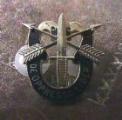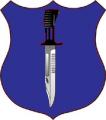Don't try to nail me on something that I didn't write.
I wrote "The behaviour observed in AFG is outright suicidal in modern army-on-army warfare."
A patrol moves out in several lightly armoured vehicles in terrain where it's visible beyond 1,000 m and often the convoy is even moving through a valley while surrounding mountain or hill tops are not secured.
A modern army would kill the whole convoy with ease.
An infantry squad comes in contact with the enemy, is pinned down by small arms fire and calls CAS for help.
In high end warfare, it would have been suppressed in the kill zone for 30-120 sec before being killed by mortar fire.
An outpost is established in company strength.
An army opponent would have destroyed it with artillery before its completion.
A civil engineering project is being guarded by infantry and light AFVs in an agricultural area.
Again, arty & good bye.
A patrol conducts a presence patrol.
To show yourself in army-on-army war = suicide. Even 20km deep in the division rear area.
An infantry-on-infantry contact in hilly terrain. One part of the small unit fixes, the other attempts to flank.
Competent armies have a security element in their flanks to stall flanking attempts - a two-man team with LMG suffices.
A house/compound is being assaulted. Suppressive fires + assault.
Again,a competent enemy would defend from more than one position, providing kill zones around the house from detached security elements or other fortified positions.
Infantry calls for helicopters or a Reaper drone for support.
Reaper is an easy target drone for modern battlefield air defences. Helicopters couldn't dare to fly high, much less over enemy-controlled terrain if they faced a modern opponent.
Infantry patrols without (near)permanent concealment or cover.
A sniper pair with a heavy rifle and actual AP cartridges kills them off one by one until they reach cover or concealment. Their vest plates are being penetrated at 500+ m.
A fortified position is being assaulted by TB infantry. The defenders shoot back.
Everyone looking over the wall instead of through a tiny slit or periscope would be shot by snipers. Every position without overhead cover would be a mortar kill zone. Every fortified position that has been identified a few minutes or more ago would already be a death trap, a mere firing mission for the enemy artillery with later mopping up by infantry.
Infantry is carrying M136s on patrol through a barren environment.
An enemy IFV arrives and accepts their surrender.
NATO soldiers expected to die within weeks of WW3 even without any nuclear attacks.
Today ISAF/OEF-A endure a lower attrition rate than a per cent per year.
Any attempt to claim that ISAF/OEF-A meet the survivability demands of modern high end warfare is utterly hopeless. The threat is marginal by comparison. Look at the South Ossetia conflict. More dead than in a year in Afghanistan - in a matter of days. The forces involved were much smaller.
A marginal threat does certainly not lead to the amount of carefulness as necessary in army-on-army warfare.
I know that these statements are not capable of comforting those who serve(d) in AFG, but they're the harsh truth.
Let me refer to this for further explanation.
The TB are far more permissive than an opposing army would be. Naturally, the Western troops use this freedom of action and use tactics that would not be acceptable against a less permissive opponent.



















Bookmarks